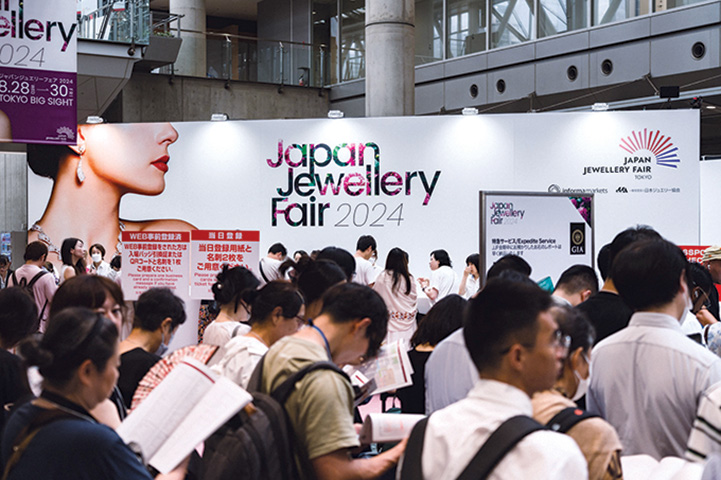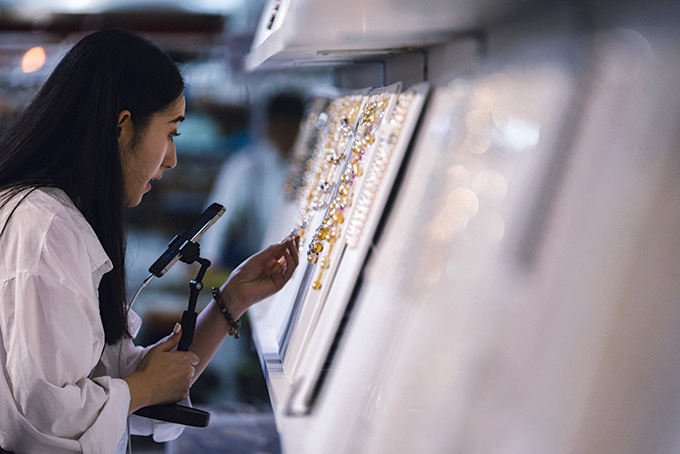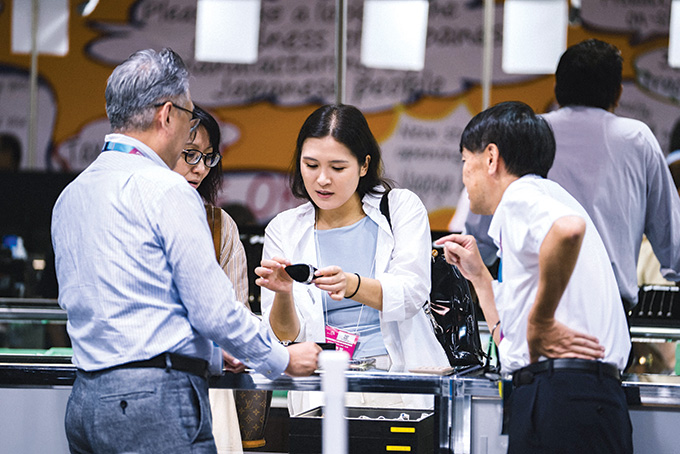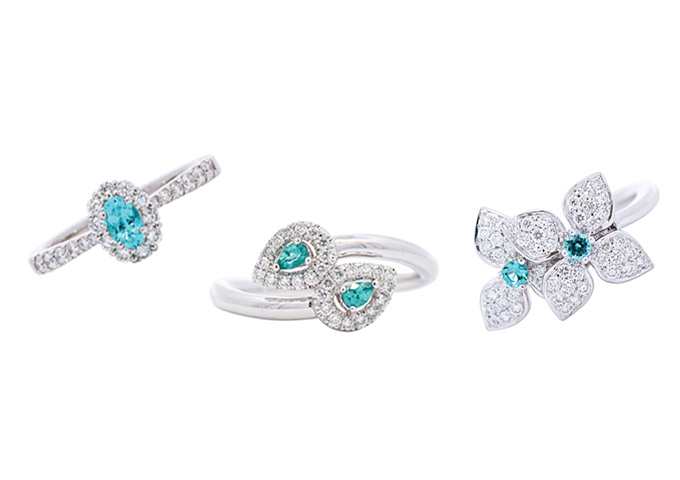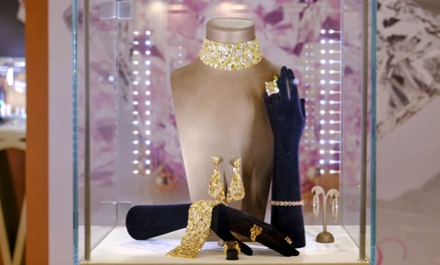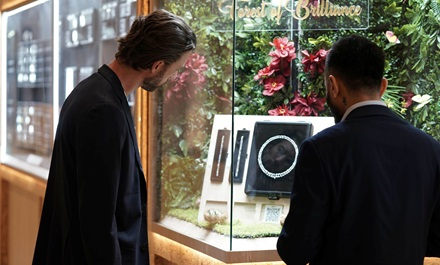The Japan Jewellery Fair (JJF) 2024 showcased Japan's jewellery manufacturing prowess. The diverse array of high-quality jewellery and innovative designs displayed at the fair garnered interest from both domestic and overseas buyers throughout the three-day event.
This article first appeared in the JNA November/December 2024 issue.
Japanese craftsmanship took centre stage at Japan Jewellery Fair (JJF), which is renowned as the largest B2B jewellery exhibition in Japan.
Organised by Informa Markets in partnership with the Japan Jewellery Association (JJA), the fair, held in Tokyo from August 28 to 30, 2024, featured 352 exhibitors from Japan and other countries and regions. The 2024 edition saw an increase in the number of overseas exhibitors and foreign buyers, particularly from Southeast Asia.
JJF 2024 welcomed 12,319 visitors, down by around 8 per cent from 2023. Exhibitors attributed the decline in footfall to the impact of Typhoon Shanshan, which made landfall in Japan on August 29. Other factors that affected business at the show were the depreciating Japanese yen, weak domestic demand and global economic instability.
Amid such challenges, the event exceeded exhibitors’ expectations, thanks to the quality of buyers who showed up at the fair.
Several exhibitors told JNA that they entertained buyers from China and Southeast Asia. Meanwhile, a livestreaming programme arranged by the organiser played a significant role in driving sales.
“Given the current market situation, the fair moved at a slower pace, mirroring the overall business in 2024. However, we still met serious buyers at the fair,” said Deepali Agarwal, founder of Japan-based coloured gemstone specialist EM Corp. “The show was satisfactory for us.”
Overseas exhibitors also leveraged the fair to tap the Japanese market. African luxury jewellery brand Patrick Mavros showcased a curated jewellery collection tailored for Japan, which caught the eye of both local and international buyers, according to its creative director Forbes Mavros. This was the Mauritius-based company's first time to join an exhibition in Asia.
“Our goal is to introduce our meticulously crafted pieces with unique nature-inspired designs to jewellery lovers in Japan and to ultimately grow our brand's international recognition," said Forbes. "We met buyers from top department stores as well as potential local partners who can support our future ambitions in Japan and Asia.”
Japan-made
Among the show’s strongest draws were Japan-made jewellery pieces, which captivated both international and domestic clients. Hyuga Hoshoku Co Ltd offered a new series of flexible, spring-like 18-karat gold rings, embellished with coloured gemstones. This was a favourite among foreign buyers, particularly from China and the Philippines.
“Demand for precious metal jewellery is growing,” said Junya Imamura, section manager of Hyuga Hoshoku. “High gold prices and the impact of a depreciating yen pose a challenge. We now use platinum, which is priced lower than gold, instead of 18-karat white gold in some of our jewellery items to control costs.”
Hyuga Hoshoku manufactures a wide range of precious metal jewellery, including pearl, coloured gemstone and diamond pieces.
Andoh Seisakusho Co Ltd likewise displayed magnetic bracelets and necklaces in 18-karat gold at the show. According to Fu Yinlong, sales representative of the company, 18-karat magnetic bracelets and necklaces were top sellers this year. “There is demand for platinum in the domestic market while Asia and other overseas regions still prefer 18-karat gold,” explained Fu. “Buyers used to purchase finished products designed by us. We now see a shift in preference as evidenced by increased orders for custom-made designs as well as jewellery components.”
Japanese pearls, meanwhile, remain highly sought after, specifically by Chinese buyers. According to Yuichi Ozawa, senior managing director of Jewelry Ozawa Co Ltd, top-quality, silvery-blue Akoya pearls are enjoying robust market demand this year.
“Pearl jewellery sales are strong in general, but we are undoubtedly experiencing a slowdown compared to last year’s peak. Business remains steady; that is all that matters” said Yuichi. Livestreaming activities were also bustling at Jewelry Ozawa's booth during the show. Yuichi explained that the company started collaborating with live sellers during the Covid-19 pandemic. To this day, this sales tactic remains highly effective.
Meanwhile, Paraiba tourmaline and fancy sapphire jewellery were front and centre at coloured gemstone jewellery specialist Iwahiro Trading Co Ltd’s display windows at JJF. Kenichi Nakazawa, president of the company, underscored the popularity of Paraiba tourmaline in the domestic market. “Our forte lies in unique designs. We use smaller gemstones in our designs to ensure a more attractive unit price for clients without compromising on the quality,” said Nakazawa, noting that competitively priced items moved faster.
Creative designs
The fair also showcased an expansive selection of innovative designs from Japanese designers and brands. Shimizu Jewelry Co Ltd shone the spotlight on new visually stunning pearl jewellery collections showcasing a three-dimensional, geometric design. Another highlight was its animal-inspired collection, which matches the pearls’ shape and colour with a specific animal motif.
“While our products may be priced slightly higher, we deliver uniqueness and top-notch quality,” said company sales manager Mami Shimizu.
Founded in 1990, Shimizu Jewelry runs its own factory where an in-house design team focuses on producing high-quality pearl jewellery. Among its clients are male buyers from Japan and China, some of whom they entertained at JJF.
Award-winning jewellery designer Norihisa Tanaka, for his part, showcased his meticulously crafted designs at JJF. A standout piece was a pair of Ginkgo Tree rings, which won the JJA Jewelry Design Awards 2023.
Inspired by the ginkgo tree, the rings consist of leaves made from a combination of 18-karat gold and platinum. The leaves are decorated with golden and Tahitian pearls, tanzanite stones and diamonds. A series of simpler versions for daily wear is also available.
Tanaka, who joined JJF for the first time, noted, “My goal was to promote and introduce my jewellery designs to a wider audience. My pieces are all handmade and exceptional. I also customise designs. I expect demand for this type of jewellery to increase in the future as consumers seek something special.”
Eye on growth
According to JJA Chairman Keita Nagahori, Japan’s jewellery retail sales rose 2.3 per cent year-on-year to Y1.0462 trillion (around US$7.33 billion) in 2023. He attributed this to the depreciation of the Japanese yen alongside a steady influx of foreign visitors.
“Japan is contending with an ageing population while the number of young people purchasing wedding and engagement rings is declining. To address this, JJA introduced the Bridal Diamond Pavilion at this year's JJF to help revitalise younger consumers’ desire for bridal jewellery, ultimately nurturing their consumption habits,” Nagahori remarked.
The JJA official also noted a 64.4 per cent year-on-year uptick in jewellery exports in 2023, reflecting steady demand for Japanese jewellery overseas. Precious metal products accounted for 82.1 per cent of total exports, with Hong Kong as a major export market, Nagahori said.




